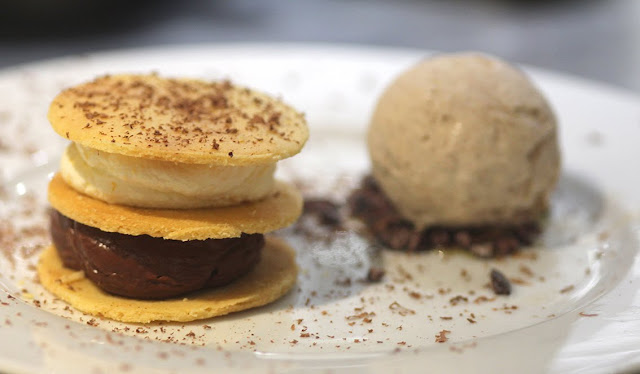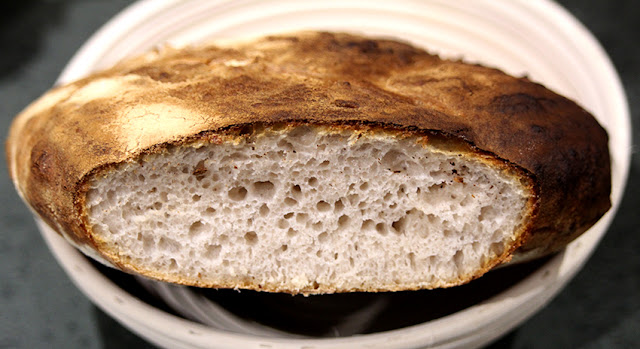My children are bored of aquafaba; tired of me whooping and swooping through the house imploring all to 'come and see, come and see'. No one is spared the miracle of my volumised bean water, not neighbours, girlfriends, Jehovah's Witnesses (You want to witness a miracle, mate, witness this!). And I'm not stopping. First it was eggless meringue, now it's chocolate mousse, tomorrow buttercream.
 Chocolate mousse is a classic of course. I was about to write velvety but what does that actually mean? When did you last lick velvet anyway? Unless you were a groupie in the 70s? Blimey, I'm trying to sell this as delicious but now Ronnie Wood's long loons loom large in my mind.
Chocolate mousse is a classic of course. I was about to write velvety but what does that actually mean? When did you last lick velvet anyway? Unless you were a groupie in the 70s? Blimey, I'm trying to sell this as delicious but now Ronnie Wood's long loons loom large in my mind.
Start again.
Chocolate mousse is a classic of course. Smooth, light, rich. Something to be served with a small spoon and licked on both sides. Traditionally made with egg white meringue and cream. This is a much simpler affair using just three ingredients: aquafaba, chocolate and sugar. This makes for a great showcase for the chocolate, uninhibited by cream.
There is an issue here though and one I keep reading about in comments under other people's recipes: graininess. I suspect what's happening is the chocolate is, partly, seizing. You'll know yourself if you mix melted chocolate with water, the result is fast, undesirable and catastrophic. the chocolate separates into solids and oils: a stiff, kludgy mess - the opposite of mousse. I think I've worked around that.
Vegan chocolate mousse.
Serves 4 (so long as they are people who would never admit they slob on the sofa and eat a whole tub of Ben and Jerry's in one sitting. )
In a fine sieve, strain the the aquafaba from one 400g can of chickpeas. Look for 'in water' rather than 'in brine'. There are many now. What you now do with the chickpeas is your own business.
 In a heatproof bowl, over a pan of boiling water, melt 200g of good, dark chocolate (I always use Valrhona). You can use milk chocolate of course but then this won't be vegan. Set aside to cool a little.
In a heatproof bowl, over a pan of boiling water, melt 200g of good, dark chocolate (I always use Valrhona). You can use milk chocolate of course but then this won't be vegan. Set aside to cool a little.
Whisk the aquafaba on full speed until light, white and very fluffy. You can try with a hand whisk but it will take a good 15 minutes.
In a small pan, add 120g of caster sugar with a tablespoon of water to make a simple syrup. Heat this to 118°C - otherwise known as 'soft ball'. A jam thermometer or temperature probe is obviously useful here but it used to to be done by dropping some syrup into water.
 With the whisk running slowly, dribble the hot sugar syrup into the aquafaba. It will increase in volume and stiffness. Whisk until cool - maybe five minutes. If this was eggwhite, we would have just made Italian Meringue. Whisking in a hot syrup cooks the mix and makes the mousse much more stable. It will tolerate refrigeration for several days.
With the whisk running slowly, dribble the hot sugar syrup into the aquafaba. It will increase in volume and stiffness. Whisk until cool - maybe five minutes. If this was eggwhite, we would have just made Italian Meringue. Whisking in a hot syrup cooks the mix and makes the mousse much more stable. It will tolerate refrigeration for several days.
Take about a third of the cooled 'meringue' and whisk it fast into the melted chocolate. You should get a thick, glossy sauce.
Now gently fold the chocolate mixture into the remaining 'meringue'. You should get a light, smooth mousse with no little bits of seized chocolate. Even if it's not smooth, it'll still be very edible. Maybe manage expectations by calling it 'silky chocolate crunch' or somesuch.








































